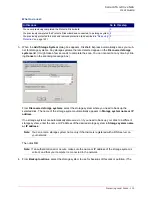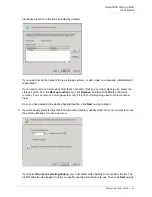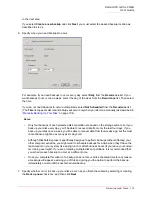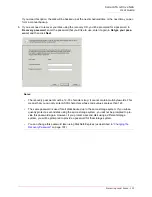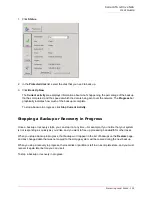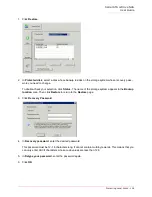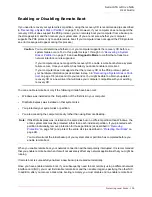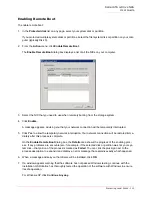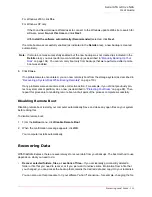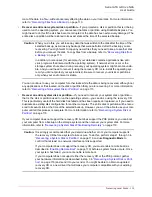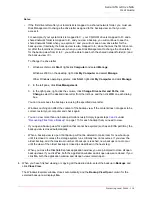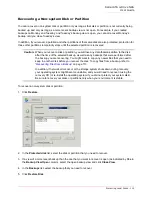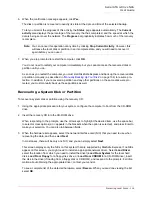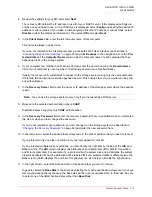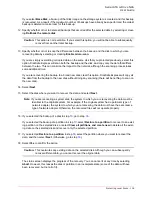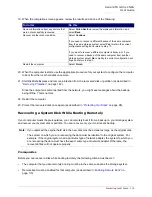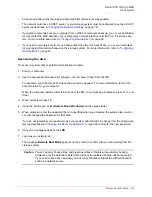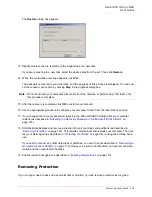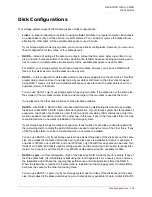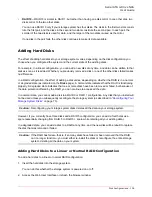
Serial ATA 4-Drive NAS
User Guide
Protecting Local Disks - 112
mat of the data in a file—without adversely affecting the data on your local disk. For more information,
refer to
“Recovering Files from a Backup”
on page 113.
•
Recover an entire non-system disk or partition
—If you protected a disk or partition that isn’t being
used to run the operating system, you can recover that disk or partition using DiskSafe Express. You
might need to do this if the disk has become corrupted or the data has been extensively damaged. The
entire disk or partition will be restored to its exact state at the time of the selected backup.
You can continue to use your computer for other tasks while the data is being recovered, although not
any applications or files located on the disk or partition that you are recovering. For more information,
refer to
“Recovering a Non-system Disk or Partition”
on page 115.
•
Recover an entire system disk or partition
—If you need to recover your system disk or partition—
that is, the disk or partition used to run the operating system—you can do so using the recovery CD.
This is particularly useful if the hard disk has failed and has been repaired or replaced, or if you need to
duplicate an existing disk configuration for another computer. The entire disk or partition will be recov-
ered to its exact state at the time of the selected backup. However, you won’t be able to use your com-
puter until all this process is complete. For more information, refer to
“Recovering a System Disk or
Partition”
on page 116.
If your computer does not support the recovery CD but does support the PXE protocol, you can boot
your computer from a backup on the storage system and then recover your system disk. For more
information, refer to
“Recovering a System Disk While Booting Remotely”
on page 119.
Caution:
When you do this, you will lose any data that was written to the disk after the time of the
selected backup, as well as any backups that were performed after the backup you are
recovering. You might want to copy any newer files that you need to keep to another disk
before you recover the disk. To copy files from a backup, refer to
“Recovering Files from
a Backup”
on page 113.
In addition, in rare cases (for example, if your data disk contains applications like anti-
virus programs that interact with the operating system), if network errors occur or the
storage system shuts down during recovery, your operating system might become unsta-
ble, and you will need to recover it using the recovery CD (or re-install the operating sys-
tem if you did not protect your system disk). Be sure to recover your disks or partitions
only when your environment is stable.
Caution:
It is strongly recommended that you determine whether or not your computer supports
the recovery CD before a system failure occurs. To do this, perform steps 1 through 3 in
“Recovering a System Disk or Partition”
on page 116 and use
Diagnostic Mode
to
confirm that at least one network interface card is supported.
If your computer does not support the recovery CD, you must enable remote boot (as
described in
“Enabling Remote Boot”
on page 110) before a system failure occurs. Once
your system has failed, you cannot enable remote boot.
If your computer does not support either the recovery CD or the PXE protocol, gather
your hardware information (as described in step 3 in
“Recovering a System Disk or Parti-
tion”
on page 116) and send it to your vendor. You might be able to obtain an updated
recovery CD or a new driver that will make your computer compatible with your existing
recovery CD.
Summary of Contents for USR8700
Page 1: ...Serial ATA 4 Drive NAS User Guide R46 1702 00 rev 0 8 04 07 ...
Page 6: ...Serial ATA 4 Drive NAS User Guide vi ...
Page 8: ...Serial ATA 4 Drive NAS User Guide Safety Instructions 8 ...
Page 46: ...Serial ATA 4 Drive NAS User Guide Getting Started 44 ...
Page 86: ...Serial ATA 4 Drive NAS User Guide Managing Your Storage System 84 ...
Page 126: ...Serial ATA 4 Drive NAS User Guide Protecting Local Disks 124 ...
Page 136: ...Serial ATA 4 Drive NAS User Guide Disk Configurations 134 ...



